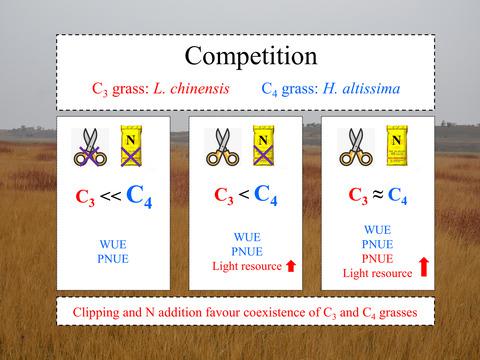当前位置:
X-MOL 学术
›
Plant Biol.
›
论文详情
Our official English website, www.x-mol.net, welcomes your
feedback! (Note: you will need to create a separate account there.)
Clipping defoliation and nitrogen addition shift competition between a C3 grass (Leymus chinensis) and a C4 grass (Hemarthria altissima).
Plant Biology ( IF 4.2 ) Pub Date : 2019-12-06 , DOI: 10.1111/plb.13064 K Wang 1 , S Zhong 1 , W Sun 1
Plant Biology ( IF 4.2 ) Pub Date : 2019-12-06 , DOI: 10.1111/plb.13064 K Wang 1 , S Zhong 1 , W Sun 1
Affiliation

|
Human-induced disturbances, including grazing and clipping, that cause defoliation are common in natural grasslands. Plant functional type differences in the ability to compensate for this tissue loss may influence interspecific competition. To explore the effects of different intensities of clipping and nitrogen (N) addition on compensatory growth and interspecific competition, we measured accumulated aboveground biomass (AGB), belowground biomass (BGB), tiller number, non-structural carbohydrates concentrations and leaf gas exchange parameters in two locally co-occurring species (the C3 grass Leymus chinensis and the C4 grass Hemarthria altissima) growing in monoculture and in mixture. For both grasses, the clipping treatment had significant impacts on the accumulated AGB, and the 40% clipping treatment had the largest effect. BGB gradually decreased with increasing defoliation intensity. Severe defoliation caused a significant increase in tiller number. Stored carbohydrates in the belowground biomass were mobilised and transported aboveground for the growth of new leaves to compensate for clipping-induced injury. The net CO2 assimilation rate (A) of the remaining leaves increased with clipping intensity and peaked under clipping intensities of 20% or 40%. Nitrogen addition, at a rate of 10 g·N·m-2 ·year-1 , enhanced A of the remaining leaves and non-structural carbohydrate concentrations, which benefited plant compensatory growth, especially for the C3 grass. Under the mixed planting conditions, the clipping and N addition treatments lowered the competitive advantage of the C4 grass. The results suggest that a combination of defoliation and N deposition have the potential to benefit the coexistence of C3 and C4 grasses.
中文翻译:

C3草(羊草)和C4草(萱草(Hemarthria altissima))之间的修剪落叶和氮添加转移竞争。
在天然草原中,人为引起的干扰(包括放牧和修剪)会导致脱叶,这很常见。植物功能类型在补偿这种组织损失的能力上的差异可能影响种间竞争。为了探讨不同浓度的限幅和氮素添加对补偿生长和种间竞争的影响,我们测量了地上生物量(AGB),地下生物量(BGB),分till数,非结构性碳水化合物浓度和叶片气体交换参数在两个地方共同存在的物种(C3草羊草和C4草Hemarthria altissima)中以单一栽培和混合栽培方式生长。对于两种草,修剪处理对累积的AGB都有显着影响,而40%修剪处理的效果最大。BGB随着脱叶强度的增加而逐渐降低。严重的落叶导致分er数显着增加。地下生物量中存储的碳水化合物被动员并运输到地下,以生长新的叶子,以补偿削波引起的伤害。其余叶片的净CO2同化率(A)随着修剪强度的增加而增加,并在修剪强度为20%或40%时达到峰值。氮添加量为10 g·N·m-2·year-1时,增加了剩余叶片的A和非结构性碳水化合物的浓度,这有利于植物的补偿性生长,尤其是对于C3草。在混合种植条件下,剪草和氮肥添加处理降低了C4草的竞争优势。
更新日期:2019-12-06
中文翻译:

C3草(羊草)和C4草(萱草(Hemarthria altissima))之间的修剪落叶和氮添加转移竞争。
在天然草原中,人为引起的干扰(包括放牧和修剪)会导致脱叶,这很常见。植物功能类型在补偿这种组织损失的能力上的差异可能影响种间竞争。为了探讨不同浓度的限幅和氮素添加对补偿生长和种间竞争的影响,我们测量了地上生物量(AGB),地下生物量(BGB),分till数,非结构性碳水化合物浓度和叶片气体交换参数在两个地方共同存在的物种(C3草羊草和C4草Hemarthria altissima)中以单一栽培和混合栽培方式生长。对于两种草,修剪处理对累积的AGB都有显着影响,而40%修剪处理的效果最大。BGB随着脱叶强度的增加而逐渐降低。严重的落叶导致分er数显着增加。地下生物量中存储的碳水化合物被动员并运输到地下,以生长新的叶子,以补偿削波引起的伤害。其余叶片的净CO2同化率(A)随着修剪强度的增加而增加,并在修剪强度为20%或40%时达到峰值。氮添加量为10 g·N·m-2·year-1时,增加了剩余叶片的A和非结构性碳水化合物的浓度,这有利于植物的补偿性生长,尤其是对于C3草。在混合种植条件下,剪草和氮肥添加处理降低了C4草的竞争优势。











































 京公网安备 11010802027423号
京公网安备 11010802027423号